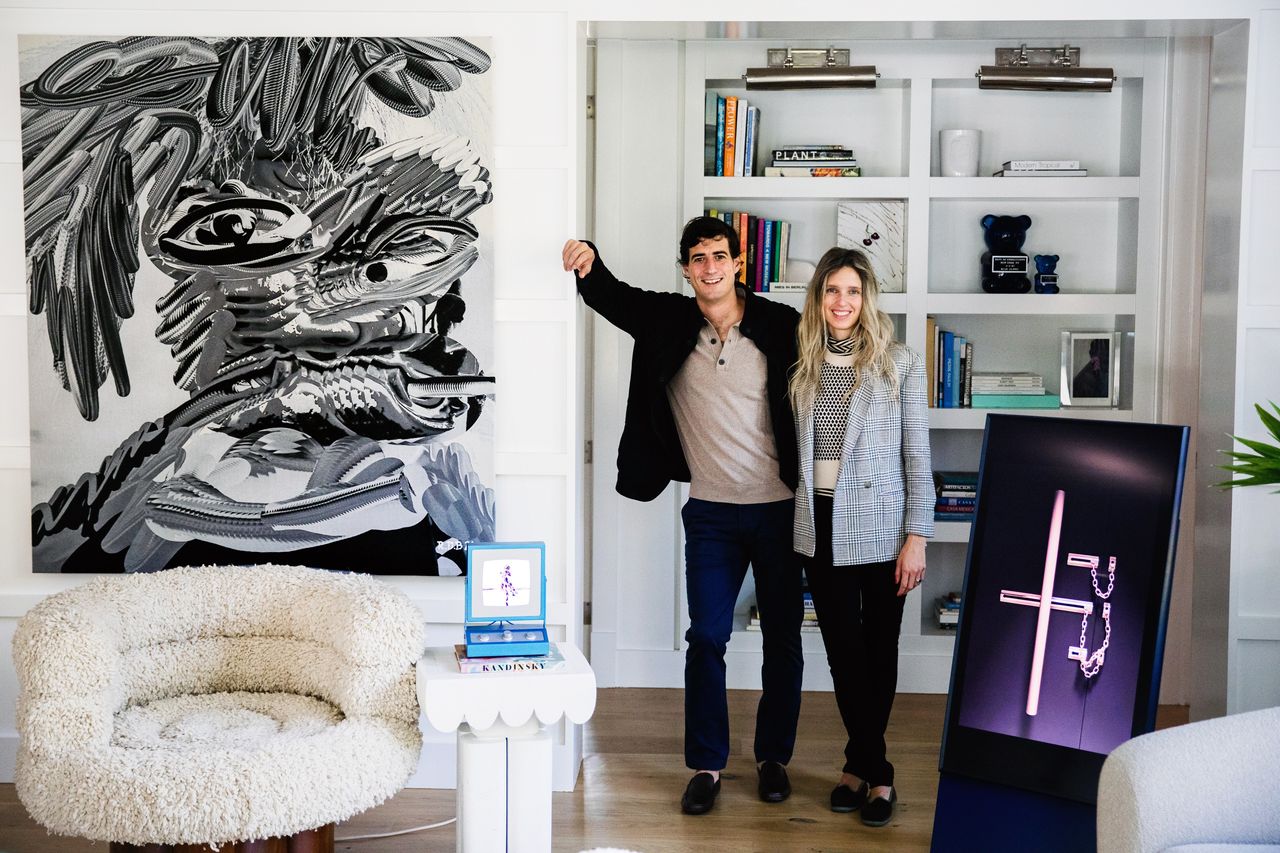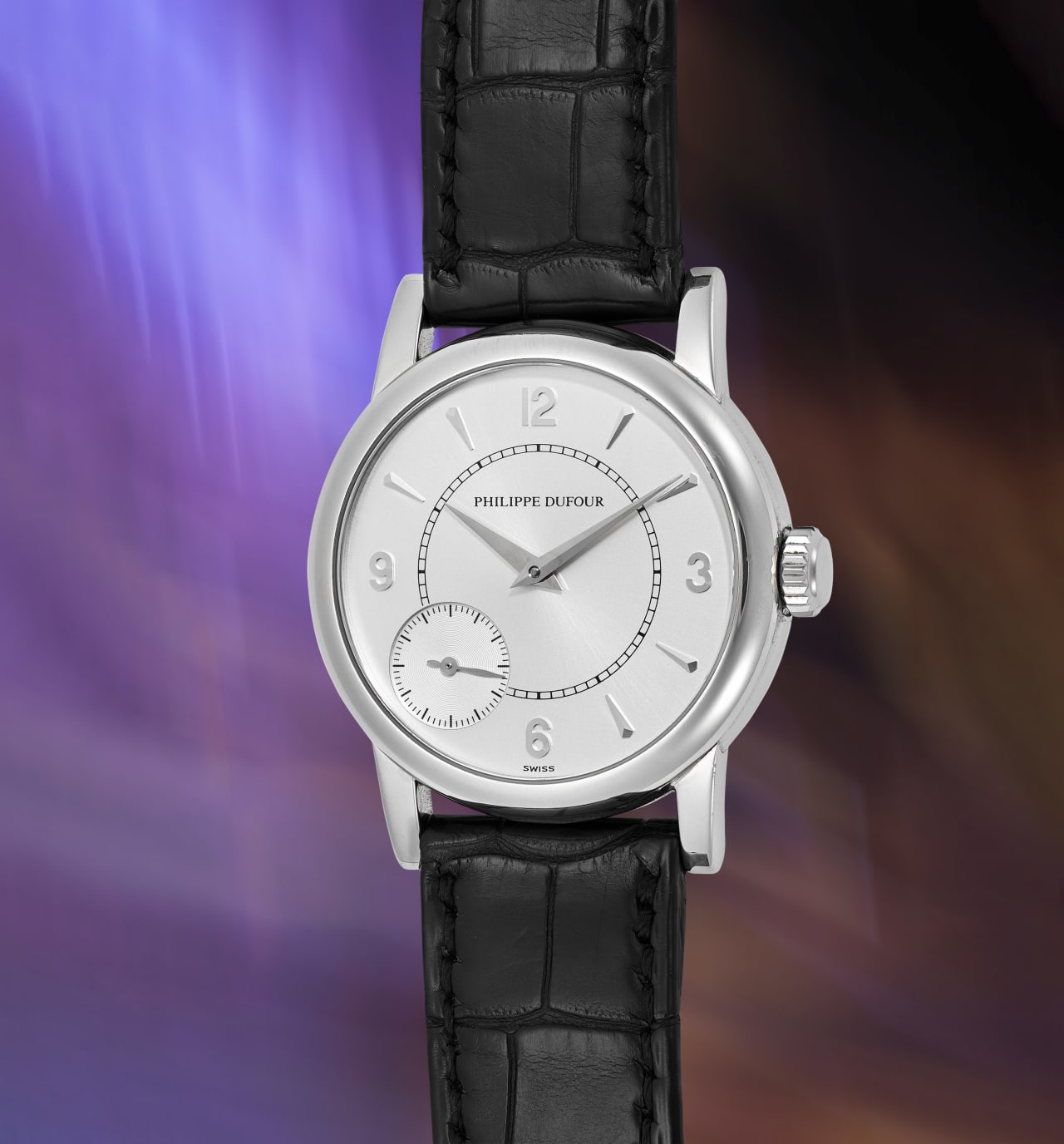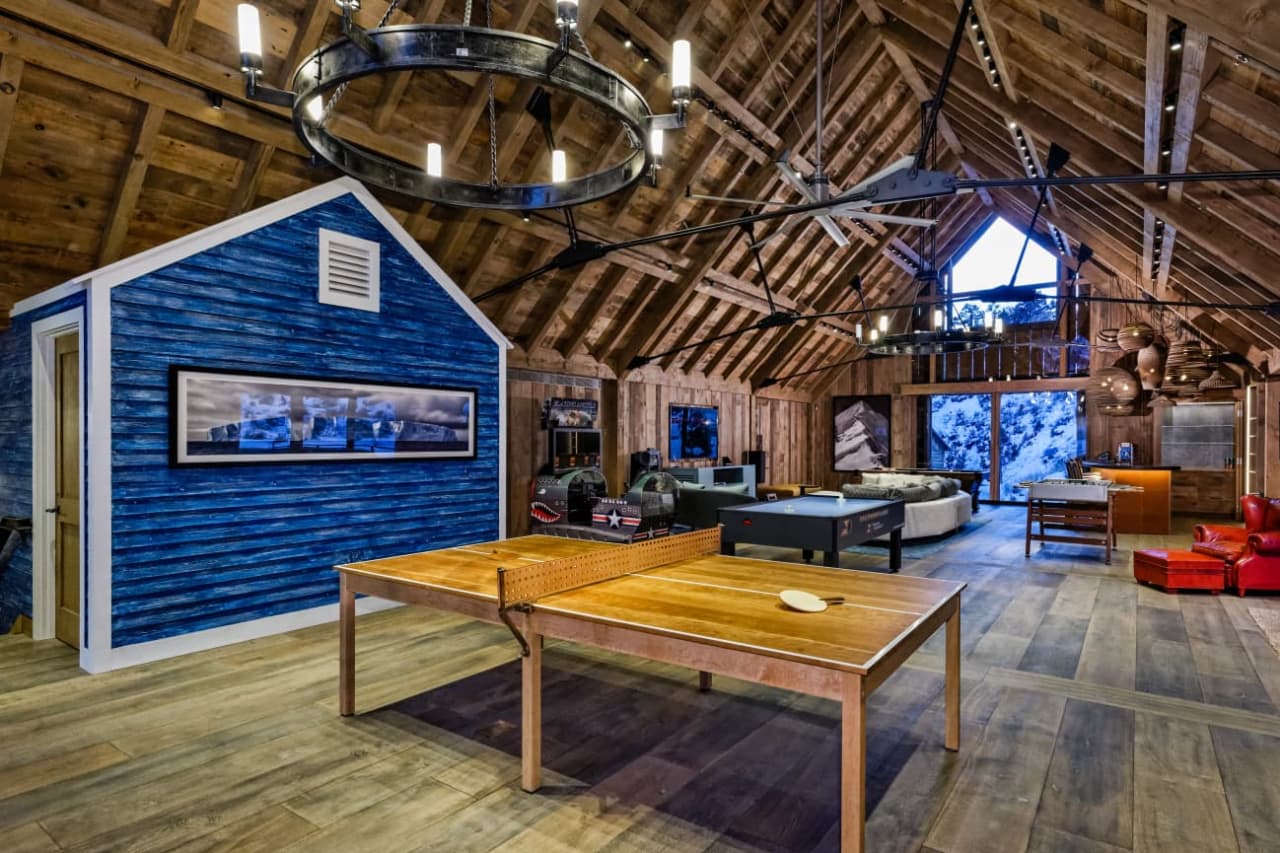NFT Art Exists Digitally. Collectors Want To Put Them On The Wall
Storing art on a hard drive isn’t doing it anymore for collectors.
Art collectors and cryptocurrency investors went wild last year buying art that exists only in the digital world. Now, Desiree Casoni, a collector in Key Biscayne, Fla., is trying to figure out how to hang all her new purchases on the wall.
Ms. Casoni owns more than 500 digital artworks with her investor husband, Pablo Rodriguez-Fraile. Bored of swiping through their collection on a cellphone or laptop, the couple initially retooled a few television sets throughout their home, but that meant downloading files onto thumb drives and plugging them in. Ms. Casoni said they next dabbled with digital picture frames designed to run looping slideshows of family photographs, but said some of these models didn’t allow them to resize or crop images.
“I don’t want to look like we live in Best Buy, with chunky black screens all over,” said Ms. Casoni.
The couple even experimented by setting a projector on a plinth in a corner of their living room and pointing it at a blank canvas hanging on a facing wall. When they turn the projector off, digital pieces such as “Elephant Dreams II,” a surrealist pink landscape by Andrés Reisinger and RAC, disappear. When it does, the white canvas alone “looks minimalist,” she said.
Collectors spent $21 billion trading digital art and collectibles last year, up from $67 million in 2020, according to digital-analytics firm DappRadar. Most of these digital artworks were attached to NFTs, or nonfungible tokens, which act as vouchers of authenticity on the blockchain for virtual goods, such as digital art.
As it turns out, those adventurous enough to buy the most cutting-edge digital media still crave some kind of real-world way to show it off at home.
Collectors say they want their physical frames and displays to match the “wow” factor of their digital art. Stephen Zautke, an investor building a house in Puerto Rico, said he plans to blanket a wall in the entry of his new home with a 6-foot-square, micro-LED screen. It is specifically designed to show highly detailed images—in his case, Refik Anadol’s digital 3-D tank of sloshing colors, “Quantum Memories Probability.”
Art adviser Yvonne Force Villareal recently advocated the same wall-size screen idea on her Instagram account, posting a video extolling the vast screen in the studio of her artist husband Leo Villareal, who just released a series of NFTs.
Steven Sacks, who runs New York’s bitforms gallery, said he has been inundated with calls from collectors seeking to frame digital works. Mr. Sacks said he tells them it is possible to get an 8-foot-wide television screen for around $14,000, though custom jobs by digital signage companies can top $150,000. He said he doesn’t recommend converting ordinary TVs that might cost a couple hundred bucks into art displays because it diminishes how the artwork is perceived.
“You shouldn’t want to turn on the football game after you click off your $100,000 artwork,” he said. “That does a disservice to the art.”
So is keeping your NFT collection locked on your cellphone, says Aaron Cunningham, a Berlin-based developer who is selling framed spots within his digital museum, Musee Dezentral, where people can exhibit their digital art. “It’s one thing to look at it on your phone, but great art needs to be elevated beyond the swipe and like,” Mr. Cunningham said.
One startup, Framed, is selling NFTs that mimic ornate picture frames. They are formatted to attach to other digital artworks so that the pair can be posted together. Tokenframe, meanwhile, lets collectors upload their NFTs directly to its physical frames. “At this point, the world is so inundated with NFTs—how can you differentiate yours to signal its worth?” said Sven Palys, Framed’s founder.
Major collectors and artists say the answer, perhaps ironically, is to go for an even more analog look. In another area of Ms. Casoni’s Florida living room sits a blue device by Swedish designer Love Hulten that evokes a vintage arcade game, only the screen shows a video-sound piece called “I Miss You” by the artists Vini Naso and Yambo. The image depicts a floating couple in an embrace, and people can turn the device’s knobs to zoom in or out.
Mr. Hulten and artist Lirona collaborated on “synth#boi,” a limestone piece whose round screen is attached to a synthesizer keyboard. Press the keys, and portions of a cheery robot face illuminate the screen. Mr. Hulten said he designed his display “in symbiosis with her art piece.” The edition of 10 quickly sold out at roughly $65,000 apiece.
Mike Winkelmann, who goes by Beeple, is another artist known for teaming with a partner to build displays for his tokenized art. In the past, he enlisted New York-based Infinite Objects to encase his work permanently within sheets of clear acrylic, objects the company calls video prints. Infinite Objects said it has shipped more than 50,000 units by him and other artists since it launched two years ago.
Recently, when Mr. Winkelmann wanted to go bigger to create his first sculpture, “HUMAN ONE,” the artist used mahogany to build a boxlike structure around a quartet of LG TV screens, which he positioned vertically. The revolving result ended up looking something similar to a phone booth, but with screens projecting a video of a man in a space suit walking in a loop. (Infinite Objects said it recently launched its own line of larger screens.)
Ryan Zurrer, a digital-art collector based in Zug, Switzerland, paid $28.9 million for “HUMAN ONE,” but he hasn’t had it shipped home yet. He already has another 80 NFT artworks but displays only a handful at home. He cites environmental reasons for not running screens all the time.
Mr. Zurrer keeps eight pieces by Mad Dog Jones, Mr. Anadol and Beeple lined up on a shelf behind his desk in his home office. To be able to turn them all on with the flip of a light switch, he had to sync them using a hidden “bucket of wires.”
The rest of his home? It remains NFT-free, he says, “until my wife finds one she likes enough to live with.”
 Copyright 2020, Dow Jones & Company, Inc. All Rights Reserved Worldwide. LEARN MORE
Copyright 2020, Dow Jones & Company, Inc. All Rights Reserved Worldwide. LEARN MORE
This stylish family home combines a classic palette and finishes with a flexible floorplan
Just 55 minutes from Sydney, make this your creative getaway located in the majestic Hawkesbury region.
As Paris makes its final preparations for the Olympic games, its residents are busy with their own—packing their suitcases, confirming their reservations, and getting out of town.
Worried about the hordes of crowds and overall chaos the Olympics could bring, Parisians are fleeing the city in droves and inundating resort cities around the country. Hotels and holiday rentals in some of France’s most popular vacation destinations—from the French Riviera in the south to the beaches of Normandy in the north—say they are expecting massive crowds this year in advance of the Olympics. The games will run from July 26-Aug. 1.
“It’s already a major holiday season for us, and beyond that, we have the Olympics,” says Stéphane Personeni, general manager of the Lily of the Valley hotel in Saint Tropez. “People began booking early this year.”
Personeni’s hotel typically has no issues filling its rooms each summer—by May of each year, the luxury hotel typically finds itself completely booked out for the months of July and August. But this year, the 53-room hotel began filling up for summer reservations in February.
“We told our regular guests that everything—hotels, apartments, villas—are going to be hard to find this summer,” Personeni says. His neighbours around Saint Tropez say they’re similarly booked up.
As of March, the online marketplace Gens de Confiance (“Trusted People”), saw a 50% increase in reservations from Parisians seeking vacation rentals outside the capital during the Olympics.
Already, August is a popular vacation time for the French. With a minimum of five weeks of vacation mandated by law, many decide to take the entire month off, renting out villas in beachside destinations for longer periods.
But beyond the typical August travel, the Olympics are having a real impact, says Bertille Marchal, a spokesperson for Gens de Confiance.
“We’ve seen nearly three times more reservations for the dates of the Olympics than the following two weeks,” Marchal says. “The increase is definitely linked to the Olympic Games.”

Getty Images
According to the site, the most sought-out vacation destinations are Morbihan and Loire-Atlantique, a seaside region in the northwest; le Var, a coastal area within the southeast of France along the Côte d’Azur; and the island of Corsica in the Mediterranean.
Meanwhile, the Olympics haven’t necessarily been a boon to foreign tourism in the country. Many tourists who might have otherwise come to France are avoiding it this year in favour of other European capitals. In Paris, demand for stays at high-end hotels has collapsed, with bookings down 50% in July compared to last year, according to UMIH Prestige, which represents hotels charging at least €800 ($865) a night for rooms.
Earlier this year, high-end restaurants and concierges said the Olympics might even be an opportunity to score a hard-get-seat at the city’s fine dining.
In the Occitanie region in southwest France, the overall number of reservations this summer hasn’t changed much from last year, says Vincent Gare, president of the regional tourism committee there.
“But looking further at the numbers, we do see an increase in the clientele coming from the Paris region,” Gare told Le Figaro, noting that the increase in reservations has fallen directly on the dates of the Olympic games.
Michel Barré, a retiree living in Paris’s Le Marais neighbourhood, is one of those opting for the beach rather than the opening ceremony. In January, he booked a stay in Normandy for two weeks.
“Even though it’s a major European capital, Paris is still a small city—it’s a massive effort to host all of these events,” Barré says. “The Olympics are going to be a mess.”
More than anything, he just wants some calm after an event-filled summer in Paris, which just before the Olympics experienced the drama of a snap election called by Macron.
“It’s been a hectic summer here,” he says.

AFP via Getty Images
Parisians—Barré included—feel that the city, by over-catering to its tourists, is driving out many residents.
Parts of the Seine—usually one of the most popular summertime hangout spots —have been closed off for weeks as the city installs bleachers and Olympics signage. In certain neighbourhoods, residents will need to scan a QR code with police to access their own apartments. And from the Olympics to Sept. 8, Paris is nearly doubling the price of transit tickets from €2.15 to €4 per ride.
The city’s clear willingness to capitalise on its tourists has motivated some residents to do the same. In March, the number of active Airbnb listings in Paris reached an all-time high as hosts rushed to list their apartments. Listings grew 40% from the same time last year, according to the company.
With their regular clients taking off, Parisian restaurants and merchants are complaining that business is down.
“Are there any Parisians left in Paris?” Alaine Fontaine, president of the restaurant industry association, told the radio station Franceinfo on Sunday. “For the last three weeks, there haven’t been any here.”
Still, for all the talk of those leaving, there are plenty who have decided to stick around.
Jay Swanson, an American expat and YouTuber, can’t imagine leaving during the Olympics—he secured his tickets to see ping pong and volleyball last year. He’s also less concerned about the crowds and road closures than others, having just put together a series of videos explaining how to navigate Paris during the games.
“It’s been 100 years since the Games came to Paris; when else will we get a chance to host the world like this?” Swanson says. “So many Parisians are leaving and tourism is down, so not only will it be quiet but the only people left will be here for a party.”
This stylish family home combines a classic palette and finishes with a flexible floorplan
Just 55 minutes from Sydney, make this your creative getaway located in the majestic Hawkesbury region.






















